 Your new post is loading...
 Your new post is loading...
Given the speed of the news cycle and the time needed video news production, social media is "the first way we break news now," says Andrew Springer, Producer of Social Integration at ABC News, in this interview with Beet.TV at SXSW.
Alternative weekly colossus Boston Phoenix cracked and fell this week, ceasing publication after 47 years. Once one of the leading alt-weeklies in the nation, the dead paper leaves behind $1.2 million in debt and roughly $500,000 in assets. ...The advertising shift from newsprint to Web is mirrored by a cultural shift. In my mind, the alt-weekly remains the perfect boredom-alleviation device. Waiting for a subway train? Pull one from your bag and it will entertain you. Your girlfriend is late for your date? The paper will keep you occupied. That beer and bag of nuts not distracting from life’s troubles as you mope on a barstool? The alt-weekly saves the day again. But even a human fossil must concede that the smartphone trumps the alt-weekly as a boredom killer. How does a wedge of newsprint compete with an affordable messaging device that ferries games, social media apps, calendars, news, feature films, scores, coupons and a library’s worth of music and reading material? Ask a young person his opinion and he’ll tell you that nothing says “geezer” like a newspaper, be it daily or alt-weekly. What’s changed, and what probably convinced the Phoenix to exit, is that the papers are no longer a 30 percent (or higher) margin business, and that lost business is not returning. Publishers who hope to survive will have to content themselves with 10 percent margins. They will have to work harder to maintain advertising categories where they still have a comparative advertising advantage, such as food and restaurants, which usually require a face-to-face meeting between an ad representative and an owner to make a sale. It’s a cliché, but I’ll toss it out there anyway: Every newspaper and website needs to compete in the events business. The smarter papers are already there, and if they’re lucky they’ll hit the jackpot the Austin Chronicle has with its decades-old SXSW business. And it doesn’t require much insight to urge alt-weekly publishers to continue building out their Web components....
If the newspaper industry had theme music in 2013, it might use “Been down so long it looks like up to me,” the much-recycled line from a 1920s blues song. For the first time since the deep recession that began in 2007, newspaper organizations have grounds for a modicum of optimism... Companies have started to experiment in a big way with a variety of new revenue streams and major organizational changes. Some of the bright opportunities – such as offering social marketing services to local businesses – are ventures too new to be measured yet industry-wide. They show signs of stabilizing revenue.... Even halting improvement in the general economy helps the industry. The double whammy of cyclical ad losses on top of secular shift to new media has considerably eased from the worst of the recession from 2007 to 2010. Auto advertising has come back, and some markets, like Miami, are beginning to see recovery in real estate and employment ads as well. All those positives, however, are for the time being mostly promise rather than performance. The most basic indicators have not turned around. The industry is little more than half the size it once was. Considerable dangers persist... So the industry entered 2013 with some positive signs but still dealing with difficult economic realities. The two biggest newspaper developments of the last year – digital paywalls and reduced print frequency – capture that odd mix of expansion and contraction now typical within the industry....
The ticking time bomb that has defined the intersection of print and digital publishing went off over the past few weeks. It’s not the fault of any executive, technology or business model. It’s simply the beginning of a new cycle of magazine content and delivery. It you love magazines, it’s all about discovery and great value right now. If you don’t like magazines, this explosion increases the chances that you just might change your mind. Think about this: We’re coming off a week in which one of the world’s biggest publishing companies (Time Inc.) tried to sell its library to another of the world’s biggest publishing companies (Meredith). The deal fell apart. And in the same week, another global giant (News Corp) announced that its newly spun-off publishing division will get a $2.5 billion cash infusion, some of which will spawn a new WSJ.Money print magazine, and some of which will go to digital newspaper publishing. This mass change, growth, and implosion is the reality for publishers over the next few years. It’s print vs. digital, and a game of survival of the fittest. Behind the scenes, some publishing executives are clinging to the vision that print will still be the best business magazine model for the right content and the right audience. And then others are seeing the dramatic changes with the long-term view that digital models will win out. This is happening faster than most people think....
IN JANUARY the New York Times lost its top spot in comScore's ranking of the world's biggest newspaper websites to Britain's Daily Mail. The Times sniffed at the accuracy of comScore's figures, which exaggerate the Mail's online audience by including a personal-finance site that the paper owns. But the battle to be biggest reflects a growing phenomenon: national news publications going global. A mere one-quarter of the Mail's online readers are in Britain. The Guardian, which caters to those who like their news left-leaning and serious in contrast to the Mail's right-wing raciness, has one-third in Britain and another third in America (see charts). Their chief competitors are two American publications: the New York Times, which like the Guardian aims at readers of serious news, and the Huffington Post, which since its launch in 2005 has become the biggest site of the four (it is not in comScore's “newspaper” category). That the HuffPo is beating papers with a history stretching back to the 19th century is a sign of just how differently news works online....
Polis, the journalism think-tank at the LSE, has published an in-depth report looking at the value of social media to journalism, specifically public service broadcasting, and it highlights how Twitter has come to dominate news. As the report puts it, Twitter plays a more important role in newsgathering than Facebook, which is much more about discussion and far less about breaking news. Lyse Doucet, the BBC’s Chief International Correspondent puts it this way: “There is no question, if you are not on Facebook and Twitter, you are not getting the full story”. More telling is the comment from Joanna Carr, editor of BBC Radio 4′s news programme ‘PM’, who said she “wouldn’t hire anybody who doesn’t know how to use Twitter”....
Newspapers will never be the same. But what happens to democracy if the Web business model can't fund journalism? ...The assumption is that there has to be a way to make profits doing digital journalism if journalists and owners simply wise up and get with the program. Over the past few years, many American newspapers have been purchased on the cheap by hedge funds—nearly a third of the twenty-five largest dailies are now so owned—the subtext being that these business geniuses can generate profits where dummkopf journalism industry types have failed. As John Paton, the journalist-cum-CEO for a newspaper company purchased by the Alden Global Capital hedge fund in 2011, put it: “We have had 15 years to figure out the web and, as an industry, we newspaper people are no good at it.” Apparently, neither are the hedge fund managers. David Carr wrote in July 2012 that “hedge funds, which thought they had bought in at the bottom, are scrambling for exits that don’t exist.”...
When to trust a theory over hard data, why companies that try to do too much get picked apart by competitors, and why sometimes industries have to learn the same lessons over and over. ...Skok said news organizations often do study their history, but they don’t focus enough on what’s coming next. Looking at profit and loss statements every quarter emphasize a snapshot of the past; Clay’s work says no, don’t only trust that balance sheet — trust a theory to predict what will happen in the future. But the idea of running large companies based on theories over hard numbers is a tough sell, Skok said. As disruption occurs, it commoditizes layers in the value stack — what used to be a high-value-added activity, one others couldn’t easily replicate, becomes cheap and easy. In journalism, the Internet, wireless technology, and other technologies have broadened the market for information. As a result, Christensen said, everyone has access to more information than they could possibly use. But that doesn’t mean that the whole indusry has become commoditzed and profitable: Commoditization opens up opportunities in adjacent layers in the value stack, he said. What you thought was a commodity becomes more profitable and proprietary — so even as one business dies, it opens up new opportunities. He cited the example of Forbes, whose previous core business — a print magazine — has been commoditized, but which has made interesting new moves online....
When everyone has the ability to blog, tweet and publish, traditional media have a greater responsibility to provide ethical, credible journalism. That was a message that emerged from the World Summit on the Information Society (WSIS) conference taking place this week at UNESCO headquarters in Paris.
In the context of the Summit’s discussions on ethics, the World Association of Newspapers and News Publishers (WAN-IFRA) and the World Editors Forum (WEF) panel focused on the role of traditional media in the digital age.
In the digital environment, when the source of information is often unknown, it becomes more difficult to determine credibility. Is the source supporting a hidden point of view? Is the blogger offering to promote products for a fee? Does the ethical culture transfer to the online environment? The panelists explored how the tenets of traditional media - quality editorial, credibility and ethical reporting, and investigative journalism – translate in the new media landscape....
Tech site develops predictive platform to monetize traffic surges In an analytics-obsessed Web climate, everyone is chasing the big story. The problem is, more often than not, big breakout traffic scoops yield attention, eyeballs and notoriety, but very few dollars. Last month, Deadspin broke the story on the Manti Te’o girlfriend hoax, netting the site nearly 4 million pageviews. But as Gawker Media mentioned publicly following the story, the company had no technical solution in place to monetize an unforeseen surge in traffic. Gawker is not alone. Web publishers have struggled across the board with this, which is why Ars Technica has been hard at work with what could be a viable solution. At Ars Technica, Condé Nast’s 15-year-old high-brow tech site, Ken Fisher and his small in-house team were lamenting the traffic conundrum when they decided to build a real-time dashboard geared toward examining pageviews with a predictive eye toward recently posted articles that are poised to trend. "Within two days we found it was working really well," explained Ars editor in chief Fisher. “We were identifying within an hour stories that would go on to do 900,000 views. And these were not pieces you’d hear by title and think, ‘That’s going to be killer.’ One was titled, Quantum Networks May Be More Realistic Than We Thought.”...
One of the high points of last week's DLD Conference in Munich was the What's Next? panel which explored the future of media in the digital age. Buoyantly chaired by DLD host Yossi Vardi, the panel included longtime media exec Jon Miller, whose illustrious career includes stints as Chairman and CEO of AOL and Chief Digital Officer at News Corp. So, I asked Miller when we sat down at DLD, what indeed is next in digital media? Miller’s response was encouraging for content creators in TV, music, and books. Companies that actually produce digital content, he explained, will become more valuable than companies that are simply channels for distributing content. And it’s television, Miller told me, that will become the key “battleground” in the war to successfully create models for distributing digital content....
Brands are becoming publishers, but do publishers have untapped opportunities as marketing agencies? ...Rather than viewing content marketing as their impending doom, publishers should be focused on the emerging opportunities: Create and distribute content, in and out of network.Produce sponsored content (aka native advertising).Tap existing advertising partnerships, and even consider cannibalizing their advertising business in favor of a more sustainable future.Offer integrated services (i.e. content + SEO + social + PR + email + analytics). Content alone isn’t enough. As Andrew Davis (@TPLdrew), author of Brandscaping, said in a recent Marketing Agency Insider post, “Publishers are masterful content creators, and they are able to charge a premium for the services they offer by leveraging theirmarket research, existing distribution platforms, and even the talent from their editorial teams.”
And Paul Rossi (@economistrossi), managing editor of The Economist, states on Digiday, "The opportunity for media companies is to create content that’s compelling for users on behalf of advertisers. That doesn’t mean it has to be native, but the skills in telling stories are quite valuable to marketers as they build audience themselves."...
While the Knight Lab spent last week looking back at 2012, what we're really excited about is 2013 and beyond. Nieman Journalism Lab has a whole serieson what to look for in 2013, from a not-so-shabby group of journalism and technology gurus -- Amy Webb, Matt Waite, Erin Kissane and our own Miranda Mulligan among them. At the Knight Lab, we saw glimpses of the future in many projects that launched this year....
|
If the newspaper is to survive, does it become miniscule? That’s the prediction from a Dutch designer and printer, who unveiled two new takes on really tiny newspapers at the World Printing Summit on Tuesday. One prototype is a single broadsheet page, folded and refolded until it is A5 size. You open it, piece by piece, like an unfolding paper flower, to read all the content. The other version is two broadsheet pages, folded down to A4 size. Designer Koos Staal thinks these are logical designs – newspapers have been reducing size since the tabloid revolution began in 2003. But a tabloid really isn’t that small. “If you wanted to read it all, it would take three hours,” he says....
In reading the Pew Research Center's State of the News Media 2013 there were some interesting things in the sections on news magazines and digital that I thought I'd point out....
The grizzled vet and the digital native: Journalism has plenty of room for both to succeed. I spent eight years at AOL and I'll say this: I saw none of the great, all of the bad and some of the good. ... The blood sport during my AOL days was about the future of media companies — who would or wouldn’t survive the digital onslaught. Actually, it was much the same during my time at Newsweek in the 80s (who needed three newsweeklies in a broadcast world). Ditto when I joined The New York Times in the 70s (was the city big enough for both The Post and Daily News). Now, the social Web with its echo chamber turns up the volume daily — and makes it more personal, too. It’s far more about the fate of the individual journalist. That quickly gets down to the paycheck. Will there be one? How much? Who gets it — the “professional” or the pretender? Consumer demand for credible news and information is greater than ever. The problem is the 100-year-old model for producing it is forever broken. That’s why more attention must be paid to finding new ways to produce quality journalism — efficiently, at scale and at a price supported by mobile CPMs, which at best are 50% lower than desktop CPMs, which if you’re lucky come in two-thirds lower than print CPMs. In other words, a high-cost newsroom structure built for the print age will never work in a smartphone or tablet world. A few startups are experimenting with new models — Vox Media, Machinima, Bleacher Report and Storify are a few that I follow. Among traditional media companies, FORBES is the only one I know of charting a new course....
Des Moines-based Meredith, best known for Better Homes and Gardens, has discovered the secret to keeping magazines profitable... Meredith has profited from a few key strategies. They are experts at repurposing their content across multiple platforms (magazines, books, websites, mobile devices, tablets, etc.) and aggressively look beyond advertising and circulation for revenue. In print, they stay as far away from the news as possible. They are particularly successful at licensing their magazine titles’ names to major national businesses selling branded products; they also run their own marketing agency. Meredith hasn’t been immune to the forces battering the industry. But over the past decade, by strategically tweaking their portfolio, they’ve managed to maintain steady profits and reliable margins year after year in spite of the turbulence. (Lacy declined to comment.) In February, Meredith published one of its signature editorial products—a “bookazine” called Chicken Dinners. It was flush with ads, co-branded under the Better Homes and Gardens imprimatur, and sold with no expiration date. In theory, it could live on a newsstand—or a coffee table or a kitchen counter—for many months. “Chicken Dinners is Chicken Dinners whether you buy it in May, June, or July,” says Samir Husni, the director of the Magazine Innovation Center at the University of Mississippi. Some 88 years after Harold Ross launched The New Yorker with the pitch that it was “not edited for the old lady in Dubuque,” Iowa is turning into a surprising seat of power....
I will never forget Bob Feit, the mad Hungarian who ran the newsroom I landed in right after college. When the news really excited him, he would pound his fist on the rim (a horseshoe-shaped copy desk), then jump on his desk and wave his arms with utter joy. “I love the news,” he would yell. The slot man, a Brit who wolfed down onion sandwiches for lunch, would express mild amusement as he continued to move copy to Carmine, a.k.a. Ace, the gruff-on-the-outside, sweet-on-the-inside teletype operator. I also remember Feit (no one ever called him Bob) because he taught me to write concisely. He would sit to my right, cut my two-sentence news briefs in half, then tell me to fill them up with facts. When I finished, he would do it again. To this day, I write my posts with Feit in mind, knowing he’d easily find words to cut....
...The media loves to attach labels to trends. When one catches on, the rush begins. Native advertising (the buzzword of choice right now), social advertising, content marketing and sponsor curation all revolve around the notion of brands as publishers. Everyone’s jockeying for position, FORBES included. Marketers want a bigger voice. The media business needs revenue. The digital world demands change. So, what’s required for this new form of marketing — and for journalism to continue to flourish? Ah, here’s where the fun begins. Buzzfeed talks about viral content. The Huffington Post is into “aligning content and paid advertising strategies.”The Atlantic uses “Sponsor Content Presented By (pick the advertiser). Gawker’s done something similar (it’s actually now talking about a commerce play). As for us, I often talk about brand journalism. BrandVoice is based on the philosophical belief that marketers, with deep understanding of their industries, can offer smart insights, too. In most traditional media companies, that’s a tough sell. Journalists can barely swallow the advertorial — it must be placed in the print or digital equivalent of Siberia. The fact is is, with the click of a mouse or the touch of a screen, the audience can check a marketer’s veracity as easily as it can a journalist’s....
Striking the right balance on social media channels can be difficult enough, but what if your brand is behind a pay wall? The Drum chats to the Financial Times’s social media manager Rebecca Heptinstall and communities editor Sarah Laitner about why the brand is still with the times as it celebrates its 125th year.Is there a certain platform you prefer working on? Rebecca Heptinstall: Twitter is very much the Financial Times’s favoured social network in sheer community size (2.75m) and traffic to FT.com. That’s not to say that other social networks aren’t important, they certainly are – for example, we were the first newspaper to reach 1m followers on Google+ in July 2012. We’re also figuring out what platforms fit with the brand as and when they pop up – for us it’s less about being everywhere and more about being represented well in a few places....
We've all seen how profoundly the Internet has disrupted industries such as music, travel and even florists. But what's easy to miss is that it's not even close to finished yet. In fact, the Internet's impact is just getting started in most other industries. And it's also revolutionizing business practices across all industries. One of these is marketing. Yet most companies have no idea of how big a change digital is bringing, and they certainly aren't prepared for what's coming. As with any such change however, there are opportunities as well as threats. The companies that are aware of the transition and find ways to use it to their advantage will be the net beneficiaries. Those that do not are likely to slowly fade into obscurity....
...For the past few years, we as an industry have been asking (often with great consternation): What is a digital magazine? All of the magazine titles I mentioned are answering this question differently. Some have created a news feed. Others, a video channel. Many repurpose their print articles into blog posts. The smart ones have created a searchable archive of past issues. A few just beg you to download their app. When we ask the question that way, we open the floodgates to all sorts of slop that is decidedly un-magazine. The typical guru’s answer involves heavy-handed social media. And push notifications. And monetizing your online channel by paginating just below the fold, capitalizing on viral lift, and recalibrating expectations to include a mix of advertorial content and strategically placed calls-to-action powered by a new algorithm to maximize synergistic opportunities.
Gross....
...As more people in any given newsroom are publishing to social platforms — andas more people bypass the homepage and instead use Twitter and Facebook as the entry point to any given news site — analytics companies see new opportunities to help media companies leverage real-time social data. Visual Revenue, a predictive analytics firm that focuses exclusively on media companies, is this morning rolling out a bundle of tools to help editors measure the effectiveness of social publishing in real time. “So, if you push a story right now on Nieman Lab, 40 clicks into it you might see 17 retweets, two favorites, some manual retweets and that’s all great, actually,” Visual Revenue CEO Dennis Mortensen told me. “But how do you really add all of it up?”...
Newsweek's top editors faced a different kind of danger than the Flying Wallendas. Katharine Graham, publisher of The Washington Post and owner of Newsweek, made a habit of decapitating her editors. ...Very few “star” journalists of that time and space have made the trip to the digital world. Most of those I spoke with and saw are pretty much doing what they did 20 and 30 years ago. They’re doing it for traditional media companies that haven’t changed much either, although executives at each have convinced themselves otherwise. Those no longer working romanticized about the past. The experience also reminded me of something I repeatedly told Tim Forbes three or four years ago when I was deep into my startup, True/Slant. “There’s a new wave of of talent out there that’s going to blow past traditional journalists — and they don’t even see it coming.”
We’re fortunate to have members of that new wave at FORBES. They do their jobs differently, particularly when freed from hierarchical editing systems to build their own brands and be accountable for their own success. They relate to and engage with the audience unlike a past generation of reporters who could care less what readers thought (after all, what do they know?). Using the tools of social media, they follow their colleagues as competitive beat reporters to gain insight from them. Most important, they banter with them in full public view, a far more raw, if not real, version of any “news analysis” than shows up in newsprint. Sometimes, they even ride the crest of a competitor’s scoop by filtering it through their own eyes for different audiences. They produce their own videos, photos and galleries and podcasts to extend their reach. And they trust in Google, angling stories (and a story’s headline) to give them the best chance of reaching the world. In the video below, six people who sit in our newsroom talk about their jobs and the FORBES model of digital journalism.
...Take Twitter for example. A wonderful way in which friends can talk to friends and friends of friends who are on the spot. But, if one has a look at who has large followings, a lot of journalists are right there. In almost every case, journalists who have the largest followers are those who are not only on the ball and on the spot but who have in successive 140 character messages been able to succinctly and accurately move information to their followers. Generally speaking, journalism needs to up its game. Professional hacks need to be able to place themselves on a much higher plane than so-called citizen journalists and bloggers. What they write and say has to be structured in a way that oozes professionalism and integrity, relevance and credibility....
|
 Your new post is loading...
Your new post is loading...
 Your new post is loading...
Your new post is loading...






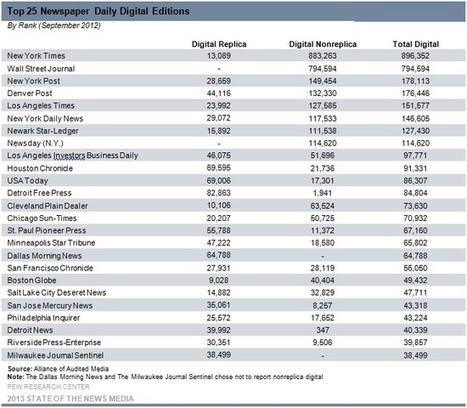

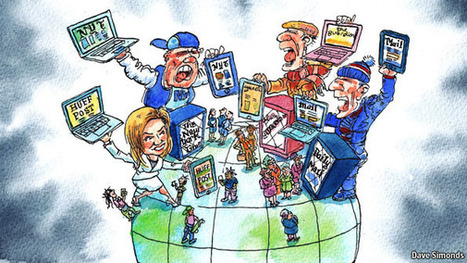


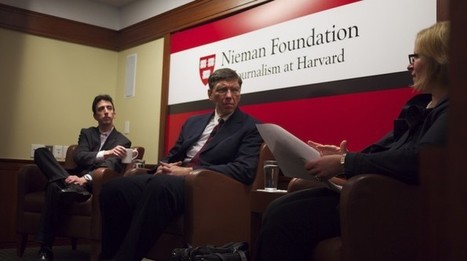



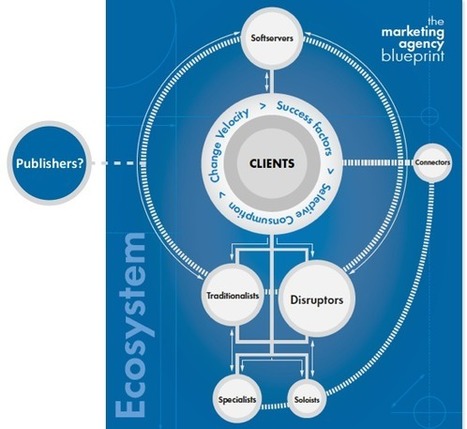





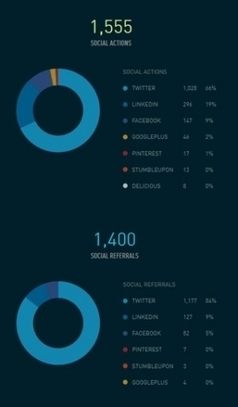











Lots of valuable insight into why TV may now be best described as "social TV" especially breaking news in social channels. The only concern is the continued need for editorial judgment, overiew and accountability in the rush to break news first.